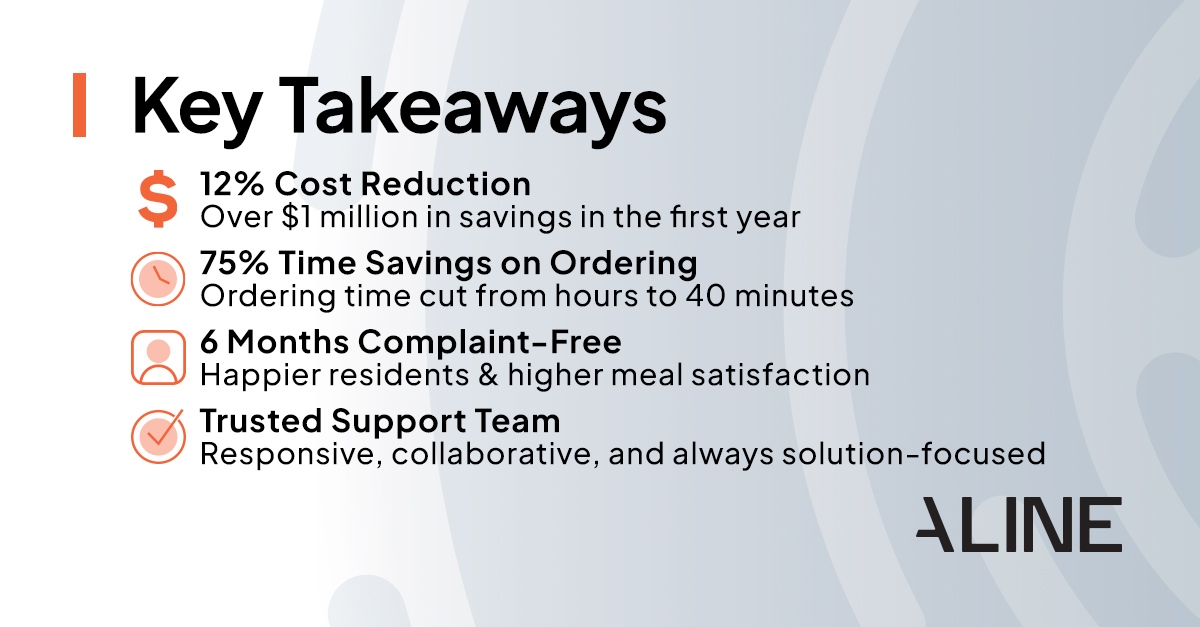How Elderwood Reduced Food Costs by 12% With Grove Menus by Aline
Smarter menu planning and streamlined ordering helped Elderwood reduce waste, lower costs, and deliver more satisfying meals to residents.

Smarter menu planning and streamlined ordering helped Elderwood reduce waste, lower costs, and deliver more satisfying meals to residents.

Dining plays a central role in resident satisfaction, but it’s also one of the most expensive services to deliver, given its unique set of operational challenges. From fluctuating food prices to operational inefficiencies, delivering high-quality meals while controlling costs remains a constant challenge for many communities.
Elderwood, a provider of independent living, assisted living, and skilled nursing communities, was no exception. Without standardized menus, Elderwood struggled to manage food costs, and nutrition oversight varied from one community to the next. Each location designed its own menus, which led to inconsistent spending, inefficient ordering, and unreliable nutritional outcomes for residents.
“Every building had the opportunity to make changes to their menus with no standardization and without correctly following nutritional guidance,” said Jaime Sarvis, regional director of dietary operations at Elderwood. “We saw residents experiencing extreme weight fluctuations, and we were spending way more on food than we should have been.”
The lack of standardized menus led to heavier reliance on costly supplements and pre-made items instead of fresh, home-cooked meals. This not only drove up expenses but also limited residents’ access to higher-quality, more satisfying dining experiences.
Elderwood needed a more consistent, scalable way to improve dining experiences while keeping budgets in check. After evaluating four different menu management solutions, Elderwood selected Grove Menus by Aline for its robust menu standardization capabilities, integration with suppliers, and strong support team.
“What stood out about Grove Menus was the ability to create standardized menus across all locations while still allowing flexibility for resident preferences,” Sarvis said. “We also liked that we could shift away from pre-made food and introduce fresher, home-cooked meals.”
Elderwood implemented Grove Menus in phases, starting with introductory training and gradually rolling it out to all communities. Despite initial resistance to change, the support from Grove Menus’ team made the transition smoother.
“The team at Grove Menus was incredible,” Sarvis said. “They were proactive, answered every question quickly, and worked with us to make adjustments. We never felt like we were waiting for support.”
One of the most impactful changes was the reduction of unnecessary inventory. For instance, before implementing Grove Menus, Elderwood communities had access to 150-plus types of green beans, leading to inconsistent ordering and unnecessary spending. With Grove Menus, Elderwood streamlined inventory and purchasing, offering just two standardized options, which resulted in a more efficient and cost-effective ordering process.
“Ordering used to be a nightmare,” Sarvis said. “I’d spend three to four hours manually checking prices and picking items. Now I can do the same order in just 40 minutes — it’s a game-changer.”
Since implementing Grove Menus, Elderwood has seen significant improvements in food costs, menu consistency, and resident satisfaction. Some of its impressive results include:
Additionally, staff saw labor efficiencies in the kitchen as fewer last-minute changes meant cooks could finish shifts on time without scrambling to accommodate unexpected requests.
“We used to have constant call-downs from residents who didn’t like their meal options,” Sarvis said. “Now they can pre-select their meals in advance, so we’re not making unnecessary adjustments on the fly. That’s made life easier for both residents and staff.”
With Grove Menus in place, Elderwood is focused on continuing to refine its dining program, further reducing waste, and enhancing meal quality. While the initial transition wasn’t without challenges, the strong support and flexibility of Grove Menus helped Elderwood’s teams successfully adopt the new system.
“Change is never easy, and we definitely had some hesitation early on,” Sarvis said. “But the team at Grove Menus supported us every step of the way. We’ve never been told ‘no’ — they’re always willing to collaborate and find solutions that work for us.”
For other senior living communities considering a menu management solution, Sarvis offers this simple advice: “Call Grove Menus. The team saved us money, improved the resident experience, and made our kitchens more efficient. It’s been one of the best decisions we’ve made.”

Discover how Grove Menus can help your senior living community reduce food costs, improve operations, and enhance resident satisfaction. Book a demo to explore what’s possible for your team.